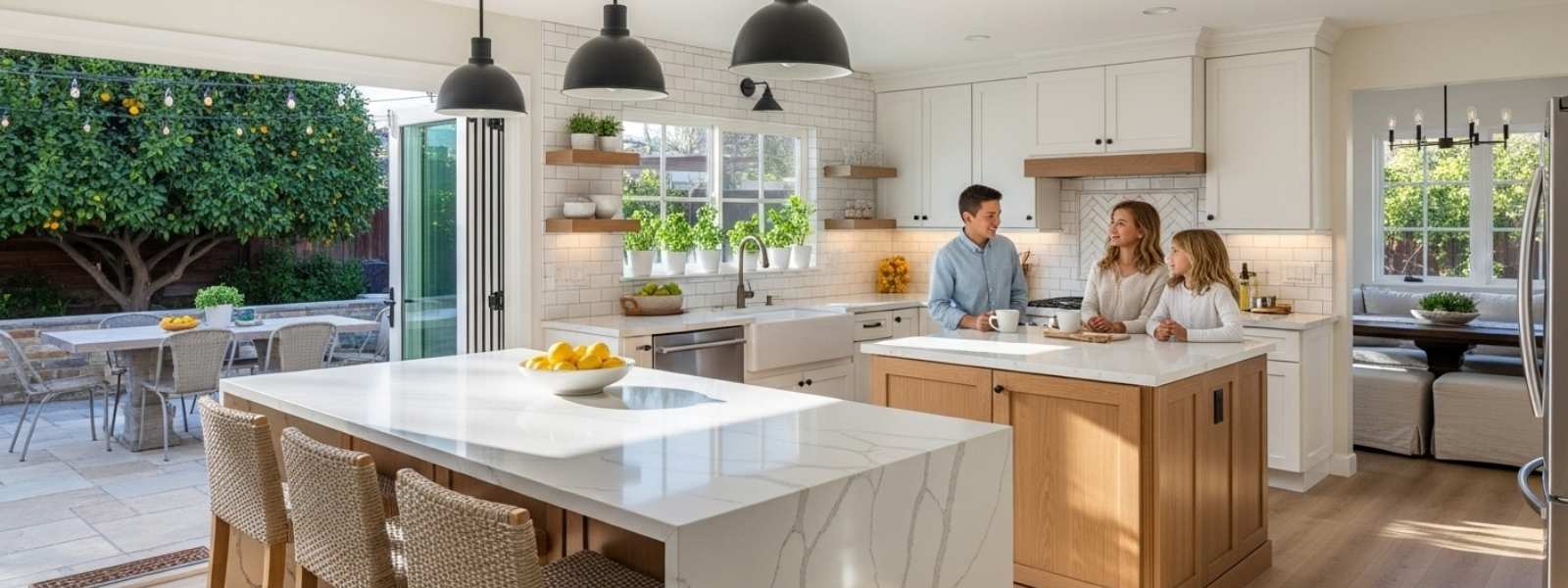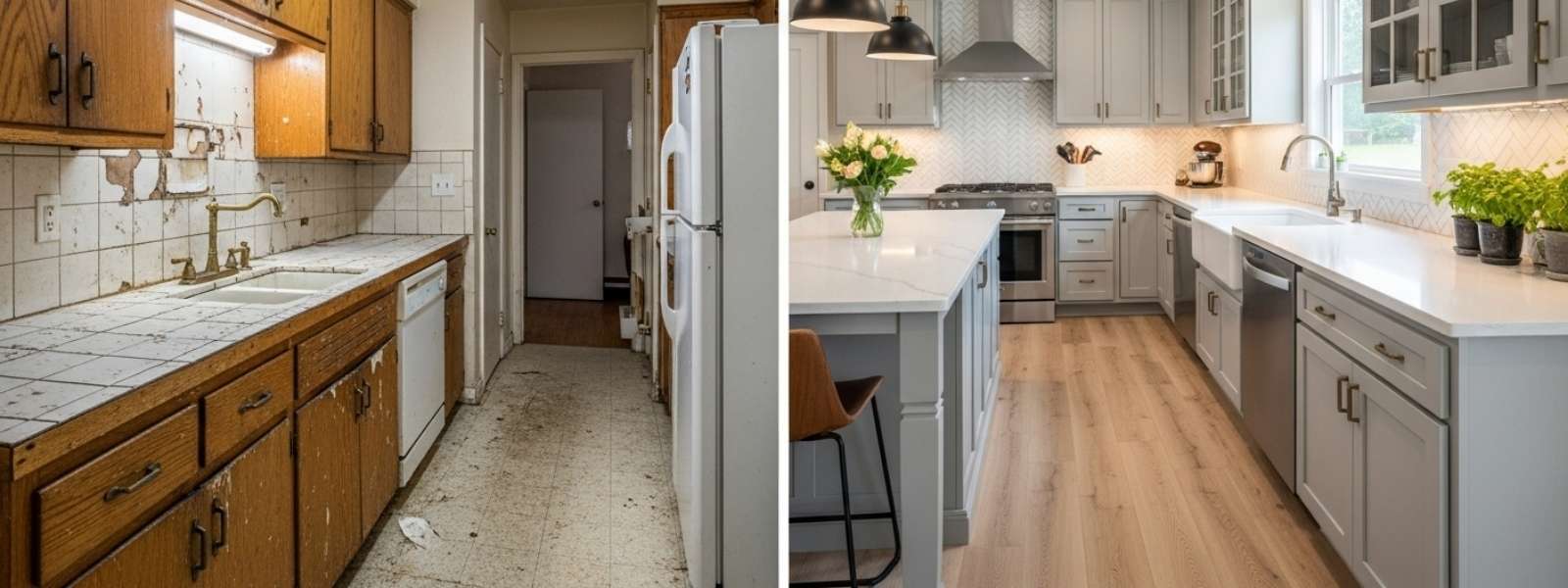
Kitchen renovations can be exciting, but they often end up costing more than planned. Many people do not realize that there are hidden costs that can appear during the process. These are extra expenses that are not included in the initial budget, such as repairs, upgrades, or unexpected fees. In this guide, we will explain the most common hidden costs in kitchen renovations and show practical ways to avoid them.
Common Hidden Costs in Kitchen Renovations
Many kitchen renovations have hidden costs that can surprise homeowners. Knowing them helps plan your budget and avoid extra expenses.
Structural Issues
Sometimes, hidden costs come from problems in the structure of your kitchen. Plumbing issues can appear when walls or floors are opened. Electrical systems may need upgrades to support new appliances or lighting. During demolition, you might discover damage in walls, floors, or ceilings that was not visible before. Fixing these problems can be expensive and take extra time. Structural repairs are often unavoidable, and not including them in the budget can lead to major surprises. Being prepared for these issues can save stress and extra costs later.
Material Upgrades
Material upgrades are a common hidden cost in kitchen renovations. Choosing premium countertops, high-end cabinets, or custom finishes can quickly increase the budget. Flooring or backsplash upgrades that were not planned in the original design may also appear. Custom features like kitchen islands, built-in storage, or specialty shelving add both material and labor costs. Sometimes, materials you initially select may not be available, leading to higher-priced alternatives. It is important to plan for possible upgrades or changes in materials to avoid unexpected expenses and ensure the renovation stays within budget.
Labor Costs
Labor costs can rise unexpectedly during a kitchen renovation. Skilled workers may need extra hours if complications occur, such as repairing structural issues or correcting mistakes. Some work may require specialist contractors, like electricians, plumbers, or designers, which adds to the cost. Even minor errors can lead to expensive corrections. Labor costs are not always obvious in the initial estimate, especially if the project takes longer than planned. Planning carefully, getting detailed quotes, and discussing potential surprises with your contractor can help manage labor costs and avoid unpleasant financial shocks.
Permits and Inspections
Permits and inspections are often overlooked but can add significant costs. Local authorities may require building permits for plumbing, electrical, or structural changes. Inspection fees may also apply to ensure the work meets safety and building codes. If work is done without proper permits, fines and additional corrections may be required. Even small renovations can trigger these requirements. Including permit and inspection costs in your budget can prevent surprises. Working with a knowledgeable contractor can help ensure all necessary permits are obtained before starting work, saving time, money, and frustration.
Appliances and Fixtures
Appliances and fixtures are another source of hidden costs. Sometimes the appliances you choose are higher-end than originally planned, adding extra expense. Delivery or installation fees can appear unexpectedly, especially for large or specialty items. You may also need additional features like water filtration, ventilation upgrades, or built-in appliances, which increase the total cost. Even small items like sinks, faucets, or lighting fixtures can add up if not included in the original budget. Planning carefully and considering all appliance and fixture costs beforehand can help avoid surprises.
Design Changes Midway
Design changes during a renovation can quickly increase costs. Homeowners often decide to change finishes, colors, or layouts after the project starts. Upgrading materials, adding features, or altering plans midway can require extra labor and materials. These changes may also delay the project and affect the overall timeline. While some adjustments are necessary, it is important to set priorities before starting the renovation. Clear communication with your contractor about desired changes and potential costs can help minimize unexpected expenses and keep your kitchen renovation on track and within budget.
How to Avoid Hidden Cost in Kitchen Renovation
Avoiding hidden costs starts with careful planning and smart decisions. By taking steps before and during your kitchen renovation, you can minimize surprises and stay within budget. The following tips cover planning, hiring professionals, contracts, long-term thinking, and inspections, making the renovation smoother and less stressful.
1- Plan Thoroughly Before Renovation
Creating a detailed plan is the first step to avoiding hidden costs. Start with a complete budget that includes a 10–20 percent buffer for unexpected expenses. List all materials, appliances, and labor needed for the project. Decide which features are essential and which are optional to avoid unnecessary upgrades. Clear planning reduces surprises and keeps the renovation organized. Reviewing the plan with your contractor ensures everyone understands the scope and helps prevent unexpected expenses.
2- Hire Experienced Professionals
Choosing the right professionals is key to avoiding hidden costs. Research contractors and designers, check reviews, and look at past projects. Hiring experienced workers reduces mistakes that can add expenses. Get multiple quotes to compare pricing and services. Skilled professionals can also advise on potential issues before they become costly. Communicating your budget and expectations clearly ensures the project stays on track, saving time, money, and stress throughout the renovation process.
3- Get Everything in Writing
Written agreements protect you from hidden costs. Ensure the contract includes the full scope of work, timeline, and all costs. Define clear procedures for any changes requested during the project. Include a payment schedule tied to milestones so you pay for completed work, not estimated progress. Written contracts prevent misunderstandings and give both parties clarity. Reviewing the contract thoroughly and asking questions before signing can save you from unexpected expenses and disputes later.
4- Consider Long-Term Costs
Thinking about long-term costs helps avoid future expenses. Choose energy-efficient appliances to save on electricity and water bills. Durable materials may cost more upfront but reduce maintenance and replacement costs over time. Designs that are easy to clean and maintain can also save money and effort. By considering longevity and durability, you avoid repeated repairs or upgrades, making your kitchen renovation more cost-effective in the long run.
5- Conduct Pre-Renovation Inspections
Pre-renovation inspections can reveal hidden problems early. Check plumbing and electrical systems to avoid costly surprises. Conduct structural assessments to detect potential damage in walls, floors, or ceilings. Inspect for mold or pests that could require additional repairs. Identifying issues before work starts prevents delays, unexpected costs, and complications during the renovation. These inspections are an investment that can save significant time, money, and stress.
Wrapping Up:
Kitchen renovations are exciting but can quickly become stressful if hidden costs appear. From structural repairs to design changes, unexpected expenses often surprise homeowners. The good news is most of these costs can be avoided with careful planning, detailed contracts, inspections, and the right professionals. Always keep a budget buffer, think long-term, and make informed choices. With the right approach, your kitchen renovation can stay on track.

